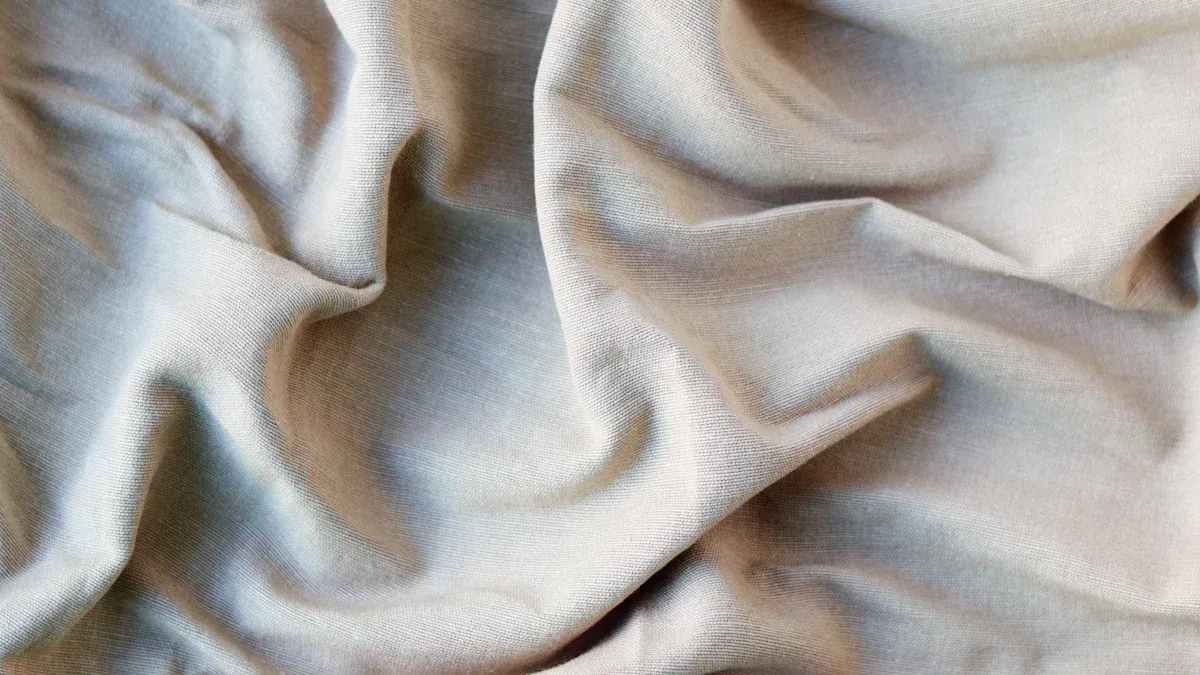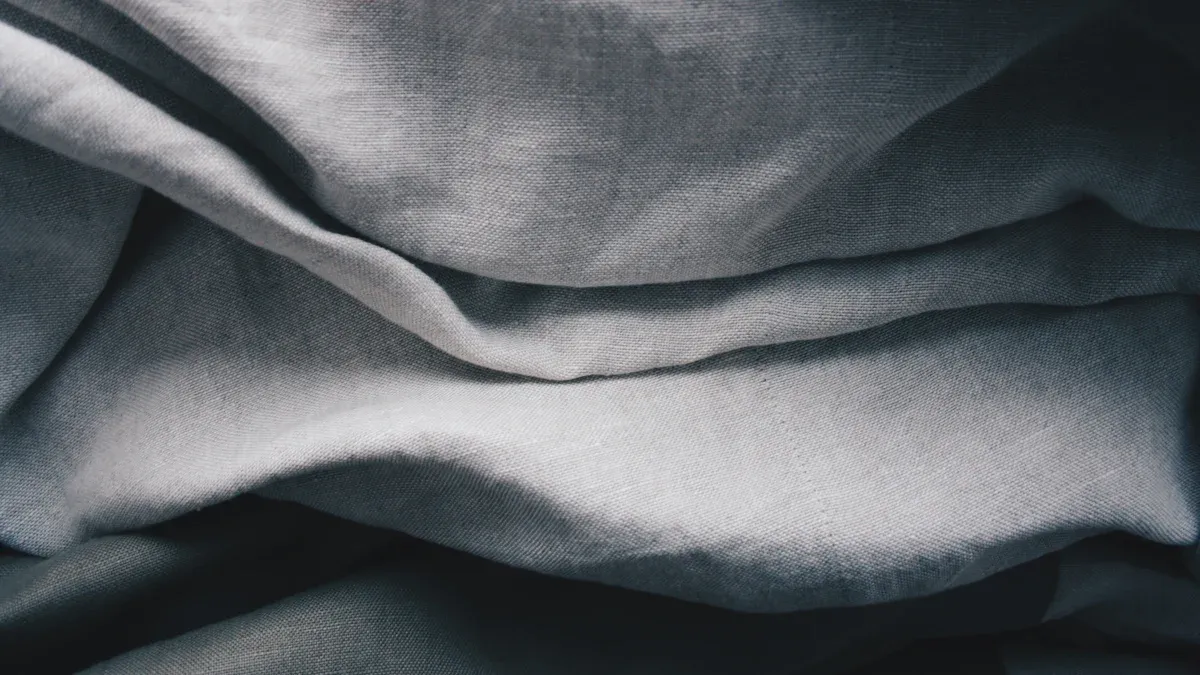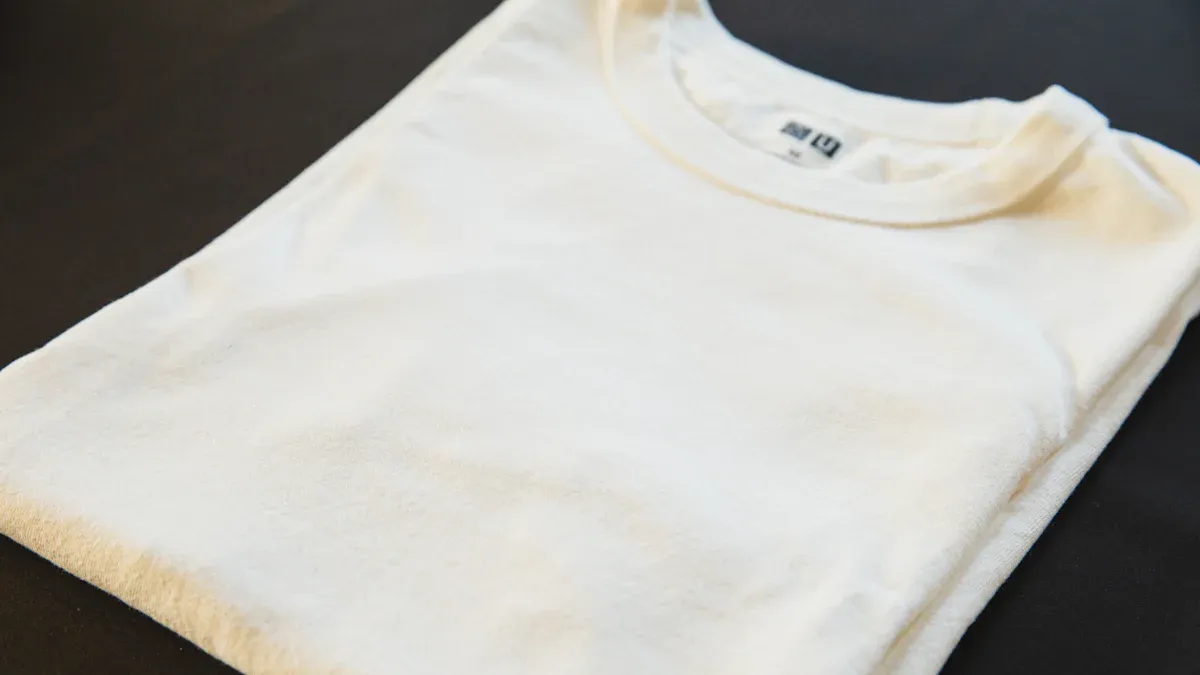
100% Cotton Jersey Fabric stands out for its exceptional comfort and breathability.
- This fabric shows higher air and water vapor permeability than blends, which allows better airflow and moisture evaporation.
- Its low thermal resistance promotes cooling, while fabric porosity increases heat loss, making it ideal for everyday wear.
Key Takeaways
- 100% cotton jersey fabric offers exceptional comfort, breathability, and softness, making it ideal for everyday wear and sensitive skin.
- This fabric requires careful care to prevent shrinkage and wrinkles; washing in cold water and air drying helps maintain its shape and feel.
- While cotton jersey is versatile and natural, it has less stretch and durability compared to blends, so consider your needs before choosing it.
What Is 100% Cotton Jersey Fabric?

How 100% Cotton Jersey Fabric Is Made
Manufacturers create 100% Cotton Jersey Fabric by transforming pure cotton fibers into a soft, stretchy knit. The process begins with cotton cultivation and harvesting. After ginning and cleaning, the fibers undergo carding and spinning to form yarn. Knitting machines then interlock the yarns, producing the signature jersey texture. Advanced machines control stitch length and pattern, which influence the fabric’s stretch and strength. Finishing techniques such as mercerizing and sanforizing improve performance and stability. Quality control follows strict protocols, including ISO standards and scientific fiber analysis, to ensure authenticity and consistency.
Note: The cost of producing 100% Cotton Jersey Fabric includes yarn, knitting, washing, dyeing, and finishing. For example, the total garment cost per dozen t-shirts can reach $28.84, with a net price per piece around $2.99. These figures reflect careful material usage and process management.
Key Characteristics of 100% Cotton Jersey Fabric
100% Cotton Jersey Fabric stands out for its comfort, durability, and versatility. Its physical properties include fabric thickness, weight (GSM), bulk density, and stitch density. The fabric offers excellent air permeability and moisture management, making it ideal for warm climates. Mechanical properties such as bursting strength, abrasion resistance, and elastic recovery contribute to its long-lasting wear. Finishing processes can further enhance these qualities.
- Increasing stitch length improves comfort by boosting air permeability and water absorbency.
- Shrinkage and spirality decrease with longer stitches, while strength and resistance to pilling increase.
A study of men’s t-shirts across retail categories shows that quality depends on fiber type, construction, and finishing, not just price. Industry standards like ASTM D4154–14 guide product specifications, ensuring reliable performance.
Benefits of 100% Cotton Jersey Fabric

Softness and Comfort
Consumers consistently rate cotton jersey as the softest and most comfortable fabric for daily wear. Over 84% of people prefer cotton clothing for its gentle touch and plush texture. The knit structure of jersey fabric enhances this softness, combining the natural feel of cotton with a slight stretch that adapts to body movement. This combination reduces friction against the skin and helps prevent irritation. Dermatological studies confirm that cotton matches lyocell in reducing itch, making it suitable for sensitive skin. The fabric’s absorbency and breathability allow it to dry quickly, maintaining comfort throughout the day. Jersey’s resistance to wrinkles further contributes to its ease of wear, ensuring garments look and feel fresh.
- Cotton jersey absorbs moisture, keeping skin dry.
- The knit construction provides a flexible, non-restrictive fit.
- Most consumers associate cotton jersey with lasting comfort.
Breathability and Coolness
100% Cotton Jersey Fabric excels in breathability and cooling properties. Laboratory tests using standardized methods measure how quickly the fabric absorbs and transports moisture, simulating real-life sweating. These tests show that cotton jersey absorbs sweat efficiently and moves it away from the skin, helping regulate body temperature. Thermal property assessments reveal that the fabric conducts heat well, which supports a cooling effect during warm weather. Contact cool feeling tests quantify the instant sensation of coolness when the fabric touches the skin, confirming its ability to provide immediate relief from heat.
Thermophysiological comfort studies highlight the importance of moisture permeability and heat dissipation. Cotton jersey maintains a comfortable microclimate between the skin and fabric, balancing heat loss and moisture evaporation. This scientific understanding explains why people often choose cotton jersey for summer clothing and activewear.
Tip: For those seeking a fabric that keeps them cool and dry, cotton jersey offers a reliable solution backed by objective laboratory data.
Natural and Hypoallergenic Qualities
Cotton jersey stands out for its natural and hypoallergenic properties. Medical professionals recommend cotton for individuals with skin conditions such as atopic dermatitis. Unlike synthetic fibers, cotton does not aggravate symptoms or disrupt the skin’s natural microbiome. Research shows that cotton supports a healthy skin barrier and helps maintain optimal skin pH. Studies also indicate that wool and synthetics can worsen skin issues, while cotton remains gentle and non-irritating. Some advanced treatments, like citric acid coatings on cellulose fabrics, further enhance cotton’s ability to reduce symptoms of skin conditions by improving the skin barrier and limiting microbial growth.
- Cotton jersey is a safe choice for sensitive or allergy-prone skin.
- The fabric’s natural composition minimizes the risk of irritation.
Versatility for Everyday Wear
Cotton jersey’s versatility makes it a staple in wardrobes worldwide. Over 70% of American adults choose this fabric for daily casual attire, including t-shirts, dresses, and leggings. The global activewear market, valued at more than $350 billion in 2023, relies heavily on jersey fabric for its comfort and performance. Cotton jersey’s softness, breathability, and durability suit a wide range of uses, from sportswear to formal fashion. Designers have embraced jersey fabric in high fashion since the 1920s, with Coco Chanel famously incorporating it into her collections. Consumers also favor jersey for lingerie, accessories, and home décor due to its flexibility and comfort.
| Aspect | Evidence / Findings |
|---|---|
| Filtration Efficiency (FFE) of 2-ply cotton T-shirt masks | Approximately 50%, comparable to level 1 medical masks with ear loops (Davies et al.) |
| High-performing cotton T-shirt mask (9 layers) | FFE between 92.3% and 98.5% (Dato et al.) |
| Breathability predictors | Pore diameter, fabric weight, and pore shape significantly affect breathability; cotton T-shirt fabrics show acceptable breathability |
| Consumer cotton categories suitable for masks | T-shirts, fashion fabrics, mass market quilting cotton, high-quality quilting cotton, home décor fabrics, bedsheets |
| Consumer cotton category with poor performance | Bandanas (due to poor filtration and variable FFE ranging from <5% to 49%) |
| Statistical model performance | Explained 81% of variation in mask fit testing and 92% of breathability based on fabric characteristics |
| Edge leakage comparison | Cotton masks have less edge leakage than medical masks with ear loops, resulting in similar overall aerosol protection despite lower material filtration efficiency |
| Practical benefits | 2-ply cotton masks are low-cost, sustainable, can be sewn at home or by volunteers, and provide alternatives when medical masks are scarce or costly |
| Limitations | Study tested 52 cotton fabrics, a small fraction of all cotton types; some fabrics like flannel not included; hydrophilic nature of cotton affects filtration but can be improved with treatments |
Jersey fabric’s adaptability extends to undergarments, accessories, and even eco-friendly home products. Its sustainability and eco-label certifications further increase its appeal for environmentally conscious consumers.
Drawbacks of 100% Cotton Jersey Fabric
Shrinkage and Wrinkling Issues
Shrinkage remains one of the most common concerns with 100% Cotton Jersey Fabric. After washing, garments often lose their original dimensions, which can affect fit and appearance. Quantitative studies show that the degree of shrinkage depends on the knit structure, yarn type, and stitch pattern. For example, fabrics with tuck loop stitches shrink more than those with float or miss loop stitches. Loop length and stitch density also play a role in how much the fabric contracts after laundering. While some finishing processes can reduce shrinkage, most cotton jersey items still require careful washing and drying to maintain their shape.
Wrinkling presents another challenge. Although some cotton jerseys offer moderate wrinkle resistance, many still crease easily, especially after washing or prolonged wear. This tendency to wrinkle means that users often need to iron or steam garments to restore a smooth appearance. The need for extra care can be inconvenient for those seeking low-maintenance clothing.
Less Stretch Compared to Blends
Cotton jersey fabric provides a natural stretch due to its knit construction, but it cannot match the elasticity of blended fabrics that include spandex or polyester. This limited stretch can restrict movement in certain applications, such as activewear or fitted garments. When compared to blends, pure cotton jersey may feel less flexible and may not recover its shape as effectively after being stretched.
Common issues related to stretch and fit include:
- Curling at the edges, especially after cutting or washing
- Skewed wefts, which can distort the garment’s shape
- Snagging and easy shedding, which affect both appearance and comfort
These drawbacks can make 100% cotton jersey less suitable for clothing that requires a high degree of flexibility or shape retention.
Care and Maintenance Needs
Maintaining 100% Cotton Jersey Fabric requires more effort than caring for many synthetic or blended fabrics. Cotton absorbs water readily, which means it takes longer to dry and can consume more energy during laundering. Studies indicate that cotton fabrics use up to 72% more energy than synthetics for washing, drying, and ironing. The fabric’s tendency to wrinkle and shrink also means that users must follow specific care instructions, such as washing in cold water and air drying, to preserve garment quality.
Environmental concerns also arise from the care and production of cotton jersey. Cotton cultivation demands significant water resources—up to 99.9% more than synthetic alternatives. The manufacturing process often involves chemicals like insecticides, herbicides, and bleaching agents, which can impact both the environment and the fabric’s long-term quality.
Tip: To extend the life of cotton jersey garments, always check care labels and avoid high heat during washing and drying.
Durability and Wear Over Time
Durability tests reveal that 100% cotton jersey can maintain its tensile strength and flexibility through repeated washing, especially when treated with advanced softeners. Treated cotton knitwear shows improved resilience, flexibility, and recovery from deformation, even after 20 wash cycles. However, untreated cotton jersey remains vulnerable to several types of damage:
- Abrasion and matting during transport or handling
- Discoloration and deformation from improper storage or exposure to moisture
- Curling, snagging, and skewed wefts, which reduce the garment’s lifespan
While chemical treatments can enhance durability, some loss of performance occurs after repeated laundering due to partial softener loss. The fabric’s natural fibers also make it more susceptible to shedding and pilling over time, especially in high-friction areas.
A summary of common durability and defect issues:
| Issue | Impact on Garment |
|---|---|
| Abrasion | Surface wear, thinning |
| Matting | Loss of softness |
| Discoloration | Faded or uneven color |
| Curling/Snagging | Misshapen edges, pulls |
| Large Shrinkage | Poor fit, size changes |
| Skewed Wefts | Distorted appearance |
Despite these challenges, many users appreciate the comfort and breathability of 100% cotton jersey, accepting the trade-offs in care and longevity.
Who Should Choose 100% Cotton Jersey Fabric?
Ideal Uses and Practical Examples
Cotton jersey suits individuals who value comfort, breathability, and softness in their clothing. Many people with sensitive skin or allergies benefit from its hypoallergenic properties. Athletes and active individuals often select cotton jersey for t-shirts, yoga pants, and casual sportswear because the fabric manages moisture well and allows air to circulate. Parents choose cotton jersey for children’s clothing due to its gentle touch and easy care. Designers frequently use this fabric for dresses, loungewear, and undergarments, as it drapes well and adapts to various styles.
For those seeking eco-friendly options, cotton jersey offers a sustainable choice when sourced from certified organic producers.
Common practical uses include:
- Everyday t-shirts and tops
- Lightweight pajamas and sleepwear
- Baby onesies and children’s apparel
- Soft scarves and beanies
- Casual dresses and skirts
When to Consider Other Fabrics
Certain situations call for alternative fabrics. When durability, high elasticity, or wrinkle resistance is a priority, synthetic blends or polyester knits may perform better. Quantitative analysis highlights key differences:
| Criterion/Metric | Cotton Jersey | Polyester Knit |
|---|---|---|
| Edge Similarity Score | High (fit reliable) | Low (distortion) |
| Sensitivity/Specificity | Up to 100% | High error rates |
| Accuracy | 87–100% | Unacceptable errors |
| Fabric Distortion | Minimal | Severe |
| Misclassification Rates | Very low | High |
Polyester knits often show severe edge curling, fiber loss, and distortion, which can lead to unreliable fit and high misclassification rates. In applications requiring precise fit or long-term shape retention, such as performance sportswear or technical garments, these alternatives may offer advantages.
Tip: Evaluate the intended use, required durability, and fit accuracy before selecting a fabric for specialized needs.
Care Tips for 100% Cotton Jersey Fabric
Washing and Drying Best Practices
Proper washing and drying help maintain the softness and shape of cotton jersey garments. Experts recommend using cool or cold water with mild, pH-neutral detergents. Gentle machine cycles or handwashing protect delicate or embellished items from stretching. Avoid bleach and fabric softeners, as these can weaken fibers and cause yellowing. To reduce wrinkles, remove garments from the dryer while slightly damp and smooth creases by hand. Tumble dry on low heat or air dry to minimize shrinkage and fading. For best results, iron on medium heat while the fabric is still slightly damp.
| Issue | Cause | Recommended Care Tip |
|---|---|---|
| Shrinkage | High heat in washing/drying | Wash cold; tumble dry low or air dry |
| Wrinkling | Natural fiber property | Iron damp; remove promptly from dryer |
| Fading | Friction, sun exposure | Wash inside out; avoid direct sunlight |
| Odor Retention | Absorbent nature | Air well; ensure complete drying |
Preventing Shrinkage and Damage
Laboratory tests confirm that chemical finishes, such as soft or wrinkle-free treatments, improve dimensional stability and reduce shrinkage. These finishes reinforce the fabric and increase resistance to creasing. For untreated garments, avoid high heat and do not wring or twist the fabric. Gently press out excess water after washing. Dry flat or hang to air dry, keeping items out of direct sunlight to prevent fading and stretching.
Tip: Home dry cleaning systems work well for delicate or embellished cotton jersey pieces.
Storing and Handling Properly
Proper storage preserves the quality and shape of cotton jersey. Fold heavier items to prevent stretching, and hang lighter garments on padded or wooden hangers. Store clean, dry garments in cool, dry places using breathable garment bags. Avoid plastic covers, which can trap moisture and cause mildew. Natural repellents like cedar blocks or lavender sachets help protect against pests. For seasonal storage, keep items away from direct sunlight and heavy stacking to prevent creasing.
| Study Aspect | Details / Findings |
|---|---|
| Dimensional Stability | Lower in length than width after laundering |
| Resin Treatment Effect | Reduced shrinkage to 5.1% (length), 3.2% (width) |
| Durability Expectation | <1% shrinkage after 20 wash/dry cycles for workwear |
100% Cotton Jersey Fabric delivers comfort, breathability, and versatility. Users should consider both care requirements and environmental impacts.
- Conventional cotton yields more fiber per land area, reducing some environmental effects.
- Recycled cotton lowers impacts but may decrease durability.
- Virgin cotton yarns provide superior strength and feel.
FAQ
Does 100% cotton jersey fabric shrink after washing?
Most 100% cotton jersey fabrics shrink slightly after the first wash. Manufacturers recommend cold water washing and air drying to minimize shrinkage.
Is cotton jersey fabric suitable for sensitive skin?
Dermatologists often recommend cotton jersey for sensitive skin. The fabric feels soft, contains no harsh chemicals, and rarely causes irritation.
Can you iron 100% cotton jersey fabric?
Yes, users can iron cotton jersey on medium heat. Ironing while the fabric remains slightly damp helps remove wrinkles and preserves softness.
Post time: Jul-09-2025